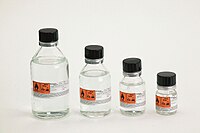
Photo from wikipedia
Recently inorganic-based metallodrugs provide an effective mechanism for the drugs on the choice of metal and its properties. Medicinal complex compounds provide an efficient platform for various pharmacological and therapeutic… Click to show full abstract
Recently inorganic-based metallodrugs provide an effective mechanism for the drugs on the choice of metal and its properties. Medicinal complex compounds provide an efficient platform for various pharmacological and therapeutic applications. Six new organotin and organosilicon complexes containing sulphur and nitrogen donor atoms were synthesised. These complexes of (E)-2-((4-methoxybenzylidene)amino)benzenethiol were characterized by elemental analyses, molecular weights, conductance measurements, infrared, electronic, and NMR spectroscopy. The data analysis indicated that the Schiff base contains bidentate nitrogen sulfur (NS) domains and was coordinated to silicon (Si) and tin (Sn) moieties via the imine-N and thiolic-S atoms, resulting in penta- and hexa-coordinated complexes in 1 : 1 and 1 : 2 ratios, respectively. The geometries around the Sn and Si atoms in complexes 1, 3, and 5 were five-coordinated and 2, 4, and 6 were six-coordinated octahedra, respectively. Density functional theory (DFT) was used to determine the optimal structural parameters. The antimicrobial activities of the ligand and its complexes were determined. These data indicate that metal complexes are more effective against bacteria and fungi in comparison to the free ligand. Molecular docking was performed to interpret the interaction of protein and various complexes and it was observed that compound 6 showed the highest binding affinity.
Journal Title: Dalton transactions
Year Published: 2022
Link to full text (if available)
Share on Social Media: Sign Up to like & get
recommendations!